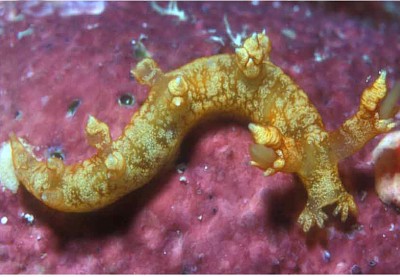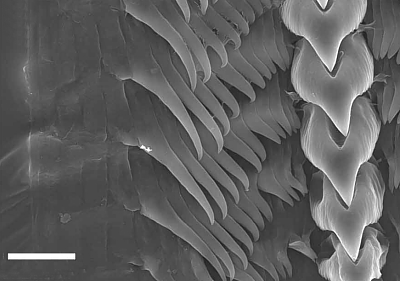

Bornella johnsonorum
Pola, Rudman & Gosliner, 2009
Order: NUDIBRANCHIA
Suborder: DENDRONOTINA
Family: Bornellidae
DISTRIBUTION
Tropical Indo-West Pacific [Marshall Islands, W. Pacific - Pola et al, 2009; Reunion Id., Indian Ocean - see Forum messages]
PHOTO
Upper: Marshall Islands, Oceanside Ennubuj-Ennylabegan reef, Kwajalein Atoll. Photo: J. Johnson. Lower: SEM of left half-rows of radular teeth (CASIZ 175405). Scale bar = 20 µm. SEM Photo: M. Pola.
The elongate body is similar in shape to other species of Bornella. The background color is a translucent straw colour with the to orange-brown viscera showing through. Epidermal and sub-epidermal white spots and patches of varying sizes are scattered all over the body wall. In some specimens, a faint, diffuse orange reticulation is visible around the whitish patches. The oral tentacles on each side of the mouth are lobe-like and have up to 9 finger-like papillae arranged along the margin.
The rhinophore stalks are relatively large with 3 or 4 small papillae placed around the front and sides of the rhinophore sheath and a large unbranched posterior papilla, which when extended, is about three times taller than the other papillae. The rhinophore complex is coloured as the rest of the body except that the the tall posterior papilla on each sheath, is mostly white. The rhinophores are translucent white with a minute orange tip.
There are five to six pairs of dorso-lateral processes, with one or two small, unpaired processes near the tail. The first dorso-lateral process on each side has two or three secondary papillae on the outer side while the second and third processes on each side have a single outer secondary papillae. Behind these there are no secondary papillae. Small tripinnate gills can occur on the inner surfaces of all processes, but can be absent, and usually are smaller on the posterior ones. The lateral papillae are predominantly white and lack subapical orange rings. It grows to at least 20 mm in length.
Although Bornella johnsonorum is very similar to B. stellifer, external and internal features can distinguish both species. In color, Bornella johnsonorum lacks the orange subapical rings found on the papillae of the oral tentacles, rhinophore sheaths and dorso-lateral processes of B. stellifer. Internally, there are differences in aspects of the radula, alimentary canal and reproductive system.
This species is known only from specimens collected in the Marshall Islands by Scott and Jeannette Johnson after whom the species is named. It was found at night in ledges and caves at depths ranging from eight to 15 m.
- Pola, M., Rudman, W. B. & Gosliner, T. M. (2009) Systematics and preliminary phylogeny of Bornellidae (Mollusca: Nudibranchia: Dendronotina) based on morphological characters with description of four new species. Zootaxa, 1975, 1-57.
Rudman, W.B., 2009 (January 27) Bornella johnsonorum Pola, Rudman & Gosliner, 2009. [In] Sea Slug Forum. Australian Museum, Sydney. Available from http://www.seaslugforum.net/factsheet/bornjohn
Related messages
-
Bornella johnsonorum from Reunion Island [2]
From: Philibert Bidgrain, January 28, 2009 -
Bornella johnsonorum from Reunion Island [1]
From: Sully Bachel, January 28, 2009
